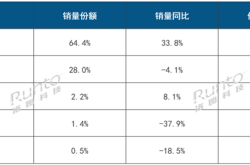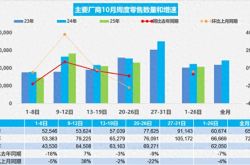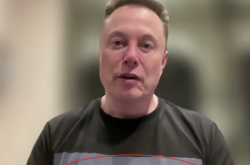Top Four Domestic Mobile Phone Brands Vie for Supremacy in 2025: Huawei Offensive, Apple Defensive, Europe Becomes the Pivotal Battleground
![]() 06/11 2025
06/11 2025
![]() 666
666

As Apple slipped out of the top five in the Chinese market, a ceasefire in the European patent wars opened a new frontier for domestic mobile phone brands.
In February 2025, the domestic mobile phone market rankings stirred up waves. Apple, with a share of 12.4%, fell out of the top five for the first time, ranking sixth, and hitting a new low in recent years. This shift not only reflects the robust rise of domestic manufacturers but also unveils profound changes in the market competition landscape. Concurrently, Huawei, fueled by strong demand for the nova 13 series and the flagship "P Series" 70 series, witnessed a 28.5% year-on-year surge in sales, reclaiming the top spot in the domestic market with a share of 19.4%.
On the other side of this fiercely competitive landscape, the European market is ushering in fresh changes. OPPO and vivo have successfully resolved patent disputes with Nokia, while OnePlus has resumed e-commerce sales in Germany. After four consecutive years of decline, the European smartphone market achieved growth in 2024 for the first time, yet Samsung, Apple, and Xiaomi still hold a firm grip on over 70% of the market share.
01 Domestic Market: Intense Competition, Huawei Leading, Apple Defensive
In China's mobile phone market in 2025, weekly rankings have been as dynamic as a revolving lantern. At the beginning of February, vivo topped the list with a share of 19.1%, while Huawei slipped to third with 16.6%. Within a month, Huawei reclaimed the top spot with 17.1%, closely followed by vivo with 16.8%. This volatility underscores the fierce intensity of market competition.
Huawei's recovery can be described as an industry miracle. Leveraging breakthroughs in Kirin chips and the maturity of the HarmonyOS ecosystem, Huawei's multi-line product portfolio spans the high-end Mate series, mid-range nova series, and foldable screen innovative models. In the first quarter of 2025, Huawei's shipments maintained a steady recovery, with flagship product supply gradually stabilizing, and mid-to-low-end products also beginning to integrate domestic chips.
The national subsidy policy emerged as a crucial variable in the market. In the first quarter of 2025, driven by the combined effects of the "national subsidy" policy and the Spring Festival sales season, China's smartphone market shipments increased by 3.3% year-on-year, reaching 71.6 million units.
The Android market capitalized on this trend, registering a 5.3% year-on-year increase, while the iOS market faced internal and external pressures, declining by 9.0% year-on-year. Apple's best-selling Pro & Pro Max models were ineligible for national subsidies, becoming a significant weakness in its market performance.
OPPO's counterattack is also noteworthy. In mid-April 2025, OPPO surpassed Xiaomi with a share of 17.0% (including OnePlus 2.1%) to rise to the second spot in the market. This leap was primarily attributed to its new product strategy: The Find X8 series continued to sell well, and the new foldable Find N5 series propelled OPPO to achieve triple-digit growth in the market above $1,000 year-on-year.
With the Reno series and sub-brand OnePlus Ace series, OPPO leads the mid-range market of $300 - $500.
The competitive landscape in the domestic market has solidified into a stable structure where six major brands account for 95.4% of the share. However, the gap between brands is minimal, with vivo, Xiaomi, OPPO, and Honor's shares concentrated within the range of 13% - 17%. Any minor misstep by any brand could lead to a drastic change in rankings.
02 Technological Breakthrough War: Foldable Screens and AI Define New Racetracks
As hardware innovation hit a bottleneck, foldable screens emerged as a breakthrough for domestic mobile phones to ascend the premium tier. In the first quarter of 2025, China's foldable phone shipments reached 2.84 million units, a year-on-year increase of 53.1%. Huawei, with its comprehensive product range, holds more than three-quarters of the market share; Honor maintains the second position in the foldable phone market with a share of 9.1%; OPPO returns to the third position with its new lightweight and large foldable Find N5 series.
Globally, the growth of foldable screens is even more impressive. Global foldable phone shipments are expected to exceed 220 million units in 2025, a 68% increase over 2024. The maturity of flexible screen technology has driven a 30% reduction in costs, and hinge durability has been enhanced to a standard of 200,000 folds. The premium capacity of foldable screen + satellite communication combination models is 18% higher than that of ordinary flagship models, proving that consumers are willing to pay more for groundbreaking features.
AI imaging technology has become a standard feature for flagship models. In 2025 flagship models, 76% are equipped with multi-frame fusion algorithms and real-time semantic segmentation technology. Leading brands achieve 3 trillion operations per second through self-developed NPUs, enabling a four-fold increase in night shooting speed. The proportion of phones supporting 8K video recording jumped from 18% in 2024 to 52% in 2025, and the penetration rate of optical image stabilization systems in mid-range models also reached 67%.
Breakthroughs in communication capabilities constitute the third technological pillar. In the third quarter of 2025, shipments of domestic mobile phones supporting Beidou short message functions exceeded 18 million units, and emergency communication scenario coverage increased to 93%. Meanwhile, the Snapdragon X85 chipset equipped with millimeter-wave technology stabilizes download speeds at over 8Gbps, pushing the proportion of 5G Advanced network users to 29%.
03 European Journey: Restarting the Market After the Patent War
After two years of patent war winter, Chinese mobile phone brands are re-entering the European battlefield. At the beginning of 2024, OPPO and vivo successively resolved patent disputes with Nokia. This settlement is significant: Before the patent litigation, OPPO + OnePlus's market share in Europe peaked at 7% - 8%, but fell to around 2% during the litigation.
The European market is recovering. In 2024, smartphone shipments in Europe (excluding Russia) increased by 5%, the first growth after four consecutive years of decline. The resilience of high-end market demand, coupled with the replacement cycle of mid-to-low-end smartphones purchased during the pandemic, provided growth momentum for the market. Samsung consolidated its position as the largest smartphone vendor in Europe with shipments of 46.4 million units, followed by Apple and Xiaomi.
Chinese brands returning to Europe adopt differentiated strategies:
- OPPO focuses on the Spanish, Italian, Romanian, and Portuguese markets.
- vivo prepares to strike: In the first quarter of 2025, it mainly relied on the "national subsidy" policy to clear channel inventory, reducing channel burden and preparing for the concentrated launch of new products across multiple price segments.
- OnePlus becomes the pioneer of the OPPO system, resuming e-commerce sales in Germany.
The challenges in the European market remain formidable. Samsung, Apple, and Xiaomi account for over 70% of the market share, with other brands holding single-digit market shares. Chinese brands' core advantages are concentrated in the price range below $600 - $700, especially in the range below $400 - $500.
Honor and realme have emerged in the European market with double-digit growth. In the third quarter of 2023, Honor became the only brand among the top five in terms of shipments in the European market to grow year-on-year (+8%), beginning to rank among the top 3%; realme stabilized its share range at 3% - 5%. TECNO and Infinix, brands under Transsion, achieved triple-digit growth in the Eastern European market through the route of ultimate cost-effectiveness.
04 Apple and Samsung's Defense and Counterattack
Faced with the fierce onslaught of Chinese brands, Apple has shown signs of fatigue in the Chinese market. In the W6 cycle of 2025, Apple fell to sixth place with a share of 12.4%, hitting a new low in recent years. Compared to the same period in 2024, its share decreased by 2.4 percentage points, with a year-on-year decline of 15%. It is particularly alarming that traditionally, the iPhone is a popular holiday gift, but during the 2025 Spring Festival, Apple failed to enter the top five.
Behind Apple's predicament lies double pressure: The high-end market is being encroached upon by Huawei, and the mid-range market faces stiff competition from Xiaomi and Honor. Geopolitical uncertainties and macroeconomic fluctuations have exacerbated Apple's pressures in the Chinese market. Analysts predict that if Apple fails to stimulate demand through price reductions before the launch of new models in September, its share may further shrink.
Samsung has demonstrated a more flexible strategy. In the European market, Samsung achieved the highest level of high-end market shipments since 2019 with the Galaxy S24 series. Its success stems from efficient marketing activities centered around Galaxy AI and the Olympics, as well as comprehensive promotional strategies.
Facing new EU regulations, Samsung took the lead in adjusting its product line: It did not launch the Galaxy A06 in Europe but provided six years of software and security support for the Galaxy A16.
Apple is attempting to recover from its decline through mid-range models. The launch of the iPhone SE4 is seen as a crucial move expected to help Apple maintain its competitiveness in the mid-range market. In the European market, the newly launched iPhone 16e is vital for Apple to sustain its competitiveness in the mid-range market and expand the reach of devices supporting Apple Intelligence.
05 Future Battlefield: Ecosystem Construction and Rule Adaptation
The new EU regulations have become a Damocles' sword hanging over mobile phone manufacturers. According to the EU Ecodesign Directive, mobile phone products must provide five years of software support and security patches by June 20, 2025. This requirement will particularly impact mass-market manufacturers. Due to limited profit margins, potential price increases may swiftly affect market demand.
Competition in the software ecosystem is intensifying. In 2025, 73% of mobile phone users supporting multi-terminal collaboration achieved smart home device linkage. Manufacturers' "Super Desktop" systems have improved the switching efficiency between mobile phones and tablets by 40%, and the sales of supporting AR glasses products have surged by 145% year-on-year. This ecological layout has propelled mobile phones to evolve from a single communication tool to an intelligent hub, and the output value of related accessories is expected to exceed 87 billion dollars in 2025.
Huawei has designated 2025 as a pivotal year for the HarmonyOS ecosystem. As the first product to come fully pre-installed with HarmonyOS Next, the "P Series" X series embodies Huawei's determination to fully promote the HarmonyOS ecosystem. However, challenges persist: Huawei cannot use Google GMS services in overseas markets. To promote its self-developed operating system abroad, it needs to continuously educate overseas consumers, which is extremely costly.
Emerging manufacturers explore new avenues for software monetization. Counterpoint's Senior Analyst Lin Keyu pointed out: "It is challenging to earn profits solely through operator channels. Mobile phone manufacturers need to explore AI-powered opportunities for traffic monetization, such as subscription content; simultaneously, strengthen operational collaboration with overseas local content providers in their app stores."
The regional reconstruction of the supply chain has become an inevitable choice under geopolitics. The expansion of the US chip export control list has increased Chinese brands' inventory turnover days by 22 days. India's manufacturing policies have prompted Chinese brands to shift production capacity to Vietnam and Mexico, and the Southeast Asian SKD model has emerged as a new cost-effective choice with a 17% advantage.
On the streets of Europe, the signs of OnePlus experience stores are relit; in Beijing's Sanlitun Apple store, customers are sparse; and in Huawei flagship stores, foldable phones are surrounded by layers of onlookers. In 2025, the key to victory in the mobile phone market extends beyond hardware parameters to encompass satellite communication coverage, cross-device ecosystem collaboration efficiency, and even the speed of adaptation to new EU regulations.
As Huawei controls 75% of the foldable screen market and OnePlus launches an offensive into Apple's tablet territory, the rules of this competition have already been rewritten. In the next three years, the mobile phone industry will enter a new stage of development that emphasizes both "functional breakthroughs and ecosystem construction." Brands that can integrate cutting-edge technology and build differentiated experiences are gaining significant competitive advantages.
Source of text and images: Official websites and the internet
Due to the dynamic nature of market data and different statistical agencies and timing, there may be slight differences in the data presented in the article.








